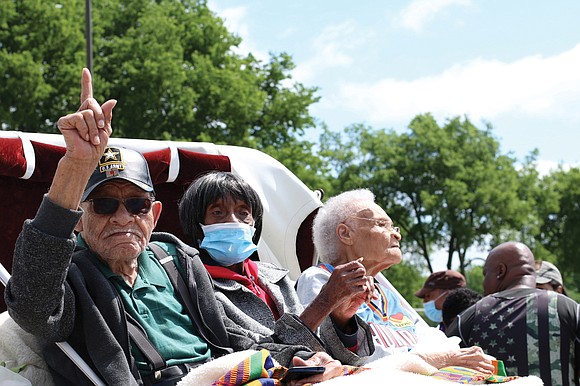’I have lived through the massacre every day’
Free Press staff, wire reports | 6/3/2021, 6 p.m.

TULSA, Okla. - She was just 7 years old when the white mob stormed through her neighborhood, killing every man they could find, raping defenseless women and burning to the ground virtually every building in a 35-block area.
Now 107, Viola Fletcher is the oldest of the three living survivors of the deliberate race-hatred fueled destruction 100 years ago of the Greenwood community, the Black section of Tulsa, Okla.
Richmond’s Black community, located 1,200 miles east, was spared the kind of terror that hit Greenwood, a two-day massacre May 31 and June 1, 1921, that left hundreds dead and which is now regarded as the largest and most horrific of the largely forgotten white mob attacks that brought death and destruction to more than two dozen growing and thriving Black communities during that era.
“I will never forget the violence of the white mob when we left our home,” Mrs. Fletcher told a congressional committee last month to which she came “seeking justice” for those impacted.
“I still see Black men being shot, Black bodies lying in the street. I still smell smoke and see fire,” said Mrs. Fletcher, one of five children her parents sought to hustle to safety. “I still see Black businesses being burned. I still hear airplanes flying overhead. I hear the screams. I have lived through the massacre every day.”
Greenwood is one of 26 communities where Black people were massacred between 1917 and 1923, according to historians. The records show that 300 people were killed in Greenwood and at least 1,100 businesses, homes and churches were destroyed by firebombs dropped from planes and blazes set from the ground.
“I am here asking my country to acknowledge what happened in Tulsa in 1921. Our country may forget this history, but I cannot. I will not, and other survivors do not. And our descendants do not,” Mrs. Fletcher said.
While Tulsa and Oklahoma still barely acknowledge the horror, President Biden traveled to that city Tuesday on the 100th anniversary to show Mrs. Fletcher that the pain and suffering is finally gaining recognition and that the federal government is committed to promoting change.
The president said what happened in Greenwood “was an act of hate and domestic terrorism with a through line that exists today, still.”
He cited the violent and deadly 2017 Unite the Right rally in Charlottesville and the Jan. 6 insurrection at the U.S. Capitol in calling white supremacy “the most lethal threat to the homeland today.”
He also toured the Greenwood Cultural Center and met with Ms. Fletcher, her 100-year-old brother, Hughes Van Ellis, and Lessie Benningfield Randle, 106, the last known survivors of the massacre.
To help provide redress, President Biden said he would use federal purchasing power to increase contracting with small, disadvantaged businesses—many of them Black- or minority-owned—from 10 percent to 15 percent, pumping an additional $100 billion in new federal spending with such companies over five years.
President Biden noted that his American Jobs Plan proposal, if passed by Congress, would provide $10 billion in community revitalization funding targeted to economically underserved and underdeveloped communities like Greenwood.
The money, according to the Biden administration, would fund remodeling of vacant buildings and storefronts to provide low-cost space for services and community entrepreneurs, including health centers, arts and cultural spaces, job training programs, business incubators and community marketplaces.
It also would support removing toxic waste to create new parks and community gardens, the administration said.
That also could benefit Richmond’s Black neighborhoods and business corridors, which have been impacted in the past by more subtle racist tools, such as highway development and urban renewal.
Such a fund also could benefit other places that were destroyed like Greenwood, including East St. Louis, where the white reign of terror was unleashed in 1917 during World War I and that culminated in 1923 with the destruction of the Black town of Rosewood, Fla.
Race massacres during that time engulfed a lengthy list of communities ranging from Chicago and Washington, D.C. to Houston, Omaha, Neb., and Elaine, Ark.
President Biden also touted other initiatives in his infrastructure bill, such as $15 billon in competitive grants targeting neighborhoods where people have been cut off from jobs, schools and businesses because of previous transportation investments, officials said.
Whether he satisfied Ms. Fletcher and the other survivors’ cry for justice is unclear. But his visit and remarks helped put the legacy of the trauma and injustice created by the massacre in the national spotlight.
Those who went through what President Biden called “a living hell,” said the event caused more than property damage.
“We were made to feel that our struggle was unworthy of justice, that we were less than the whites, that we weren’t fully Americans,” Mr. Van Ellis, a World War II veteran, said in following his sister in providing testimony to the May 19 congressional hearing.
“Even at the age of 100, the Tulsa race massacre is a footnote in the history books of us. We live it every day and the thought of what Greenwood was or what it could have been,” Mr. Van Ellis said.
Like his sister, he called for the remaining survivors of the Greenwood horror to be recognized and compensated.
“Please, do not let me leave this earth without justice,” he said, “like all the other massacre survivors.”








